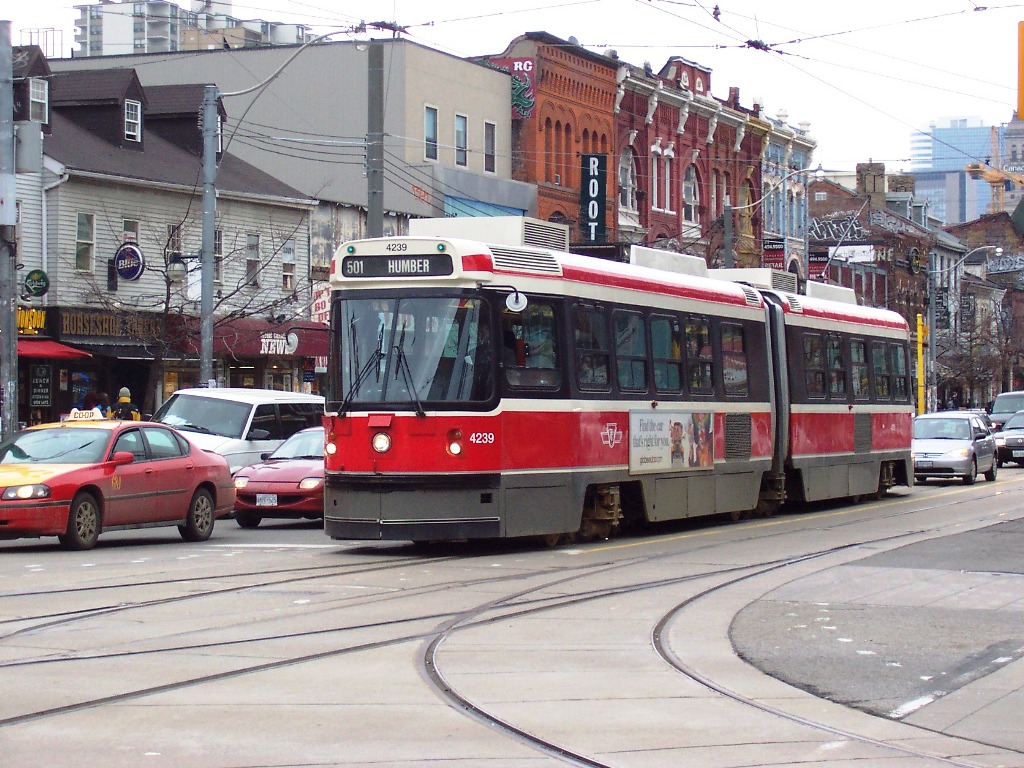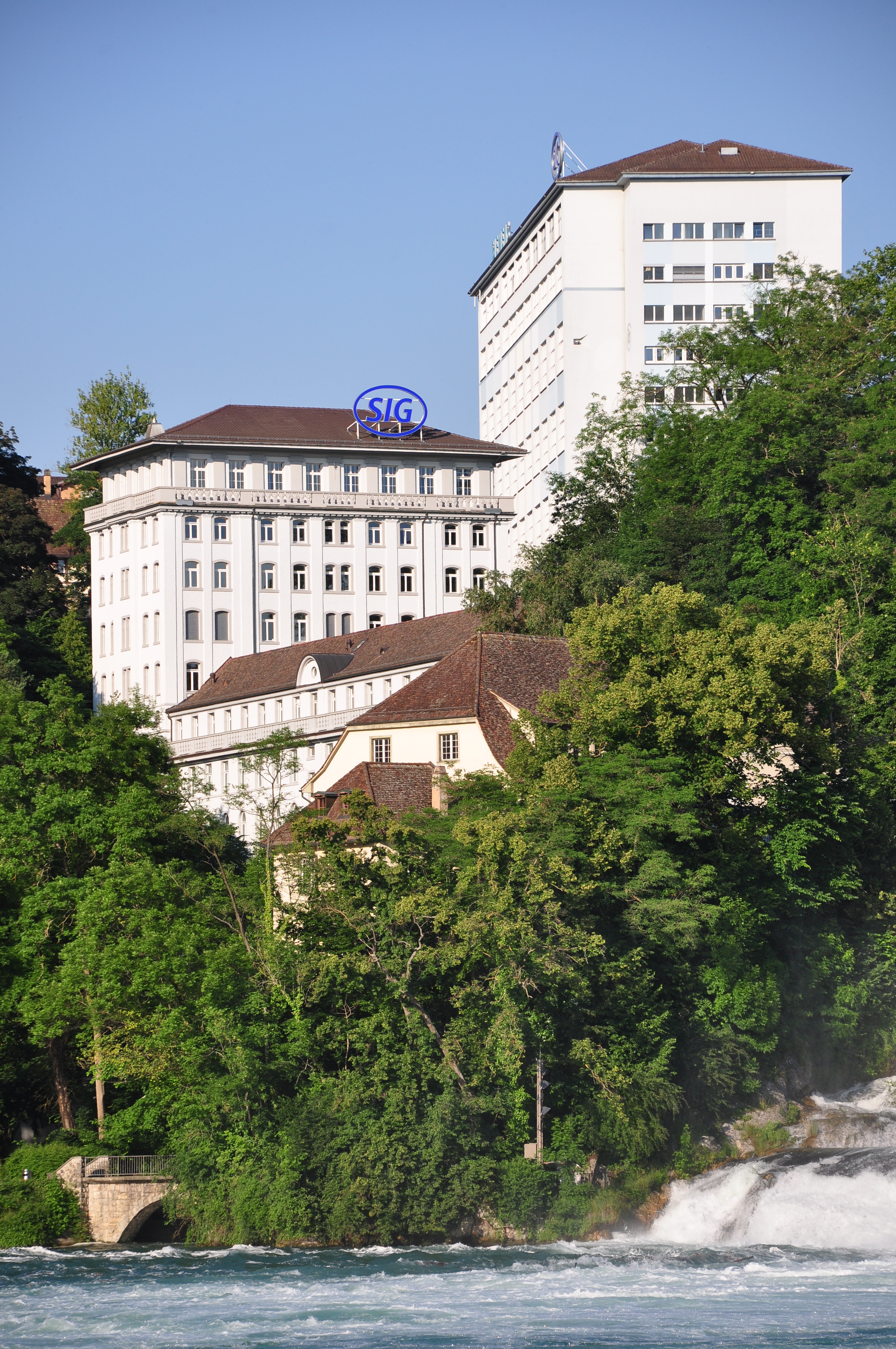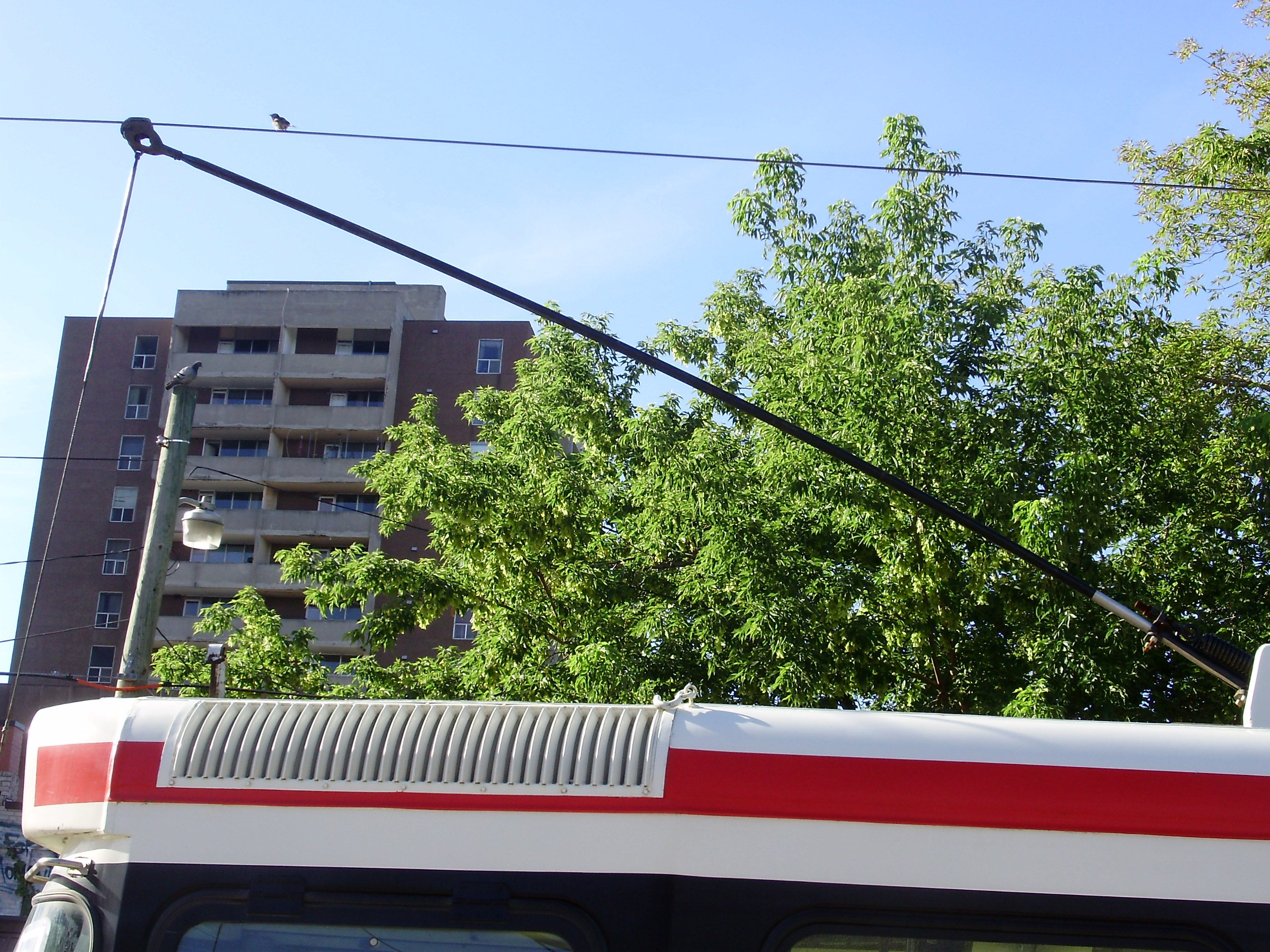|
CLRV
The Canadian Light Rail Vehicle (CLRV) and Articulated Light Rail Vehicle (ALRV) were types of streetcars used by the Toronto Transit Commission (TTC) from the late 1970s until the late 2010s. They were built following the TTC's decision to retain streetcar services in the 1970s, replacing the existing PCC streetcar fleet. Two variants were produced: the standard single-module CLRV (built between 1977 and 1981) and the longer articulated double-module ALRV (built between 1987 and 1989). The ALRVs were officially retired from regular TTC service on September 2, 2019, with the CLRVs officially retired on December 29, 2019. Both were replaced by the Flexity Outlook, a low-floor streetcar first introduced in 2014. History CLRV Starting at the end of the 1970s and into the 1980s, the TTC's fleet of PCC streetcars approached (or exceeded in some cases) the end of their useful lives. Many Toronto citizens, and especially a group known as "Streetcars for Toronto" led by transit ... [...More Info...] [...Related Items...] OR: [Wikipedia] [Google] [Baidu] |
CLRV 4059 Glamour Shot
The Canadian Light Rail Vehicle (CLRV) and Articulated Light Rail Vehicle (ALRV) were types of streetcars used by the Toronto Transit Commission (TTC) from the late 1970s until the late 2010s. They were built following the TTC's decision to retain streetcar services in the 1970s, replacing the existing PCC streetcar fleet. Two variants were produced: the standard single-module CLRV (built between 1977 and 1981) and the longer articulated double-module ALRV (built between 1987 and 1989). The ALRVs were officially retired from regular TTC service on September 2, 2019, with the CLRVs officially retired on December 29, 2019. Both were replaced by the Flexity Outlook, a low-floor streetcar first introduced in 2014. History CLRV Starting at the end of the 1970s and into the 1980s, the TTC's fleet of PCC streetcars approached (or exceeded in some cases) the end of their useful lives. Many Toronto citizens, and especially a group known as "Streetcars for Toronto" led by transit ... [...More Info...] [...Related Items...] OR: [Wikipedia] [Google] [Baidu] |
Toronto Streetcar System
The Toronto streetcar system is a network of nine streetcar routes in Toronto, Ontario, Canada, operated by the Toronto Transit Commission (TTC). It is the busiest light-rail system in North America. The network is concentrated primarily in Downtown Toronto and in proximity to the city's waterfront. Much of the streetcar route network dates from the 19th century. Most of Toronto's streetcar routes operate on street trackage shared with vehicular traffic, and streetcars stop on demand at frequent stops like buses. Toronto's streetcars provide most of the downtown core's surface transit service. Four of the TTC's five most heavily used surface routes are streetcar routes. In , the system had a ridership of , or about per weekday as of . History Pre-TTC history (1861–1921) The main predecessors of the TTC were: * Toronto Street Railway (1861–1891) * Toronto Railway Company (1891–1921) * Toronto Civic Railways (1911–1921) In 1861, the City of Toronto issued a thir ... [...More Info...] [...Related Items...] OR: [Wikipedia] [Google] [Baidu] |
Flexity Outlook (Toronto)
The Flexity Outlook is the latest model of streetcar in the rolling stock of the Toronto streetcar system owned by the Toronto Transit Commission (TTC). Based on the Bombardier Flexity, they were first ordered in 2009 and were built by Bombardier Transportation in Thunder Bay and Kingston, Ontario, with specific modifications for Toronto, such as unidirectional operation and the ability to operate on the unique broad Toronto gauge (). Excluding the TTC's heritage collection of a few older streetcars, the entire active streetcar fleet consists of the Flexity Outlook. They replaced the Canadian Light Rail Vehicle (CLRV) and its articulated counterpart, the Articulated Light Rail Vehicle (ALRV), which were all retired in December 2019. The Flexity Outlook is the first modern low-floor and wheelchair-accessible streetcar used in the city. With a length of over , they are the largest single-unit streetcars ever used by the TTC. They have four sliding doors, air conditioning systems, ... [...More Info...] [...Related Items...] OR: [Wikipedia] [Google] [Baidu] |
Toronto Transit Commission
The Toronto Transit Commission (TTC) is the public transport agency that operates bus, subway, streetcar, and paratransit services in Toronto, Ontario, Canada, some of which run into the Peel Region and York Region. It is the oldest and largest of the urban transit service providers in the Greater Toronto Area, with numerous connections to systems serving its surrounding municipalities. Established as the Toronto Transportation Commission in 1921, the TTC owns and operates Toronto subway, four rapid transit lines with List of Toronto subway stations, 75 stations, over 150 List of Toronto Transit Commission bus routes, bus routes, and 9 Toronto streetcar system, streetcar lines. In , the system had a ridership of , or about per weekday as of . The TTC is the most heavily used Public transport in Canada, urban mass transit system in Canada and the third largest in North America, after the New York City Transit Authority and Mexico City Metro. History Public transportatio ... [...More Info...] [...Related Items...] OR: [Wikipedia] [Google] [Baidu] |
Urban Transportation Development Corporation
The Urban Transportation Development Corporation Ltd. (UTDC) was a Crown corporation owned by the Government of Ontario, Canada. It was established in the 1970s as a way to enter what was then expected to be a burgeoning market in advanced light rail mass transit systems. UTDC built a respected team of engineers and project managers. It developed significant expertise in linear propulsion, steerable trucks and driverless system controls which were integrated into a transit system known as the Intermediate Capacity Transit System (ICTS). It was designed to provide service at rider levels between a traditional subway on the upper end and buses and streetcars on the lower, filling a niche aimed at suburbs that were otherwise expensive to service. Urban Transportation Development Corporation Ltd. was a holding company. During its time it held several wholly owned subsidiary companies: * Metro Canada Ltd. was established as the contracting, delivery and operating company for sys ... [...More Info...] [...Related Items...] OR: [Wikipedia] [Google] [Baidu] |
506 Carlton
506 Carlton (306 Carlton during overnight periods) is a Toronto streetcar route run by the Toronto Transit Commission in Ontario, Canada. It runs from Main Street station on subway Line 2 Bloor–Danforth along Gerrard, Carlton and College Streets to High Park. Despite the route's name, less than 10 percent of its length actually uses Carlton Street. Route :''Until the end of 2022, 506 streetcars will be diverting in both directions along Dundas Street, instead of College Street, between Ossington Avenue and Bay Street with replacement bus service operating on nearby streets. This is due to construction projects.'' The Carlton line runs from the eastern terminus of Main Street Station (on Line 2 Bloor–Danforth), initially heading south on Main Street to Gerrard Street East. It then turns west onto the upper portion Gerrard Street East to Coxwell Avenue, where it turns south to the lower portion Gerrard Street. (Coxwell Avenue is part of a jog that separates the upper and low ... [...More Info...] [...Related Items...] OR: [Wikipedia] [Google] [Baidu] |
501 Queen
501 Queen (301 Queen during overnight periods) is an east–west Toronto streetcar route in Ontario, Canada, operated by the Toronto Transit Commission (TTC). At long, it is one of the longest surface routes operated by the TTC, the longest streetcar route operating in Canada and one of the longest streetcar routes operating in the world. It stretches from Long Branch Loop (just west of Browns Line, adjacent to Long Branch GO Station) in the west to Neville Park Loop (just west of Victoria Park Avenue) in the east, running on Lake Shore Boulevard, in a reserved right-of-way within the median of the Queensway, and on Queen Street. This route operates as part of the TTC's Blue Night Network service, operating from approximately 1 am to 5 am as the 301 Queen. Since May 9, 2021, the 501 Queen route has had diversions due to construction activity. it operates from Neville Park Loop to Dufferin Street (Dufferin Gate Loop) while temporary replacement bus service operates along Que ... [...More Info...] [...Related Items...] OR: [Wikipedia] [Google] [Baidu] |
Schweizerische Industrie Gesellschaft
SIG Combibloc Group AG, originally founded as ''Schweizerische Industrie Gesellschaft'' (German for Swiss Industrial Company; in French, as ''Société Industrielle Suisse''; and, in Italian, as ''Societa Industriale Svizzera''), and later known as SIG Holding AG, is a company currently active in the Packaging industry but used to participate in firearms and railcar manufacturing as well. In 2007, SIG Holding AG was acquired by Rank Group Limited, the private investment company of New Zealand businessman Graeme Hart, and operated under its subsidiary, Reynolds Group Holdings Ltd., which, in March 2015, announced completion of its sale of SIG to ONEX Corporation of Canada. In 2018, SIG Combibloc secured a $1.101 billion loan, with Barclays Bank acting as the administrative agent on the transaction. The SIG Combibloc Group shares are listed on SIX Swiss Exchange and it is a component of the SMI MID index. History The ''schweizerische Waggonfabrik''Hermann Alexander von Berleps ... [...More Info...] [...Related Items...] OR: [Wikipedia] [Google] [Baidu] |
Trolley Pole
A trolley pole is a tapered cylindrical pole of wood or metal, used to transfer electricity from a "live" (electrified) overhead wire to the control and the electric traction motors of a tram or trolley bus. It is a type of current collector. The use of overhead wire in a system of current collection is reputed to be the 1880 invention of Frank J. Sprague, but the first working trolley pole was developed and demonstrated by Charles Van Depoele, in autumn 1885. Middleton, William D. (1967). ''The Time of the Trolley'', pp. 63–65, 67. Milwaukee: Kalmbach Publishing. . Etymology The term "trolley", also used to describe the pole or the passenger car using the trolley pole, is derived from the grooved conductive wheel attached to the end of the pole that "trolls" the overhead wire. The term "trolley" predates the invention of the trolley pole. The earliest electric cars did not use a pole, but rather a system in which each tramcar dragged behind it an overhead cable connected ... [...More Info...] [...Related Items...] OR: [Wikipedia] [Google] [Baidu] |
Halton County Radial Railway
The Halton County Radial Railway is a working museum of electric streetcars, other railway vehicles, buses and trolleybuses. It is operated by the Ontario Electric Railway Historical Association (OERHA). It is focused primarily on the history of the Toronto Transit Commission (TTC) and its predecessor, the Toronto Transportation Commission, Its collection includes PCC, Peter Witt, CLRV and ALRV, and earlier cars from the Toronto streetcar system as well as G-series and M-series Toronto subway cars. The museum is open to the public, with rides on many of its vehicles. It is located between the villages of Rockwood and Campbellville in Milton, Ontario, Canada, along part of the Toronto Suburban Railway's former right-of-way. The tracks conform to the TTC's track gauge of , which is wider than . Vehicles from other systems must be altered to accommodate the tracks, and cars intended for third-rail power must be reconfigured for use with overhead wire. In 1889, electric railway s ... [...More Info...] [...Related Items...] OR: [Wikipedia] [Google] [Baidu] |
US Standard Light Rail Vehicle
The US Standard Light Rail Vehicle (SLRV) was a light rail vehicle (LRV) built by Boeing Rotorcraft Systems, Boeing Vertol in the 1970s. The Federal Transit Administration, Urban Mass Transportation Administration (UMTA) of the United States Department of Transportation (USDOT) promoted it as a standardized vehicle for U.S. cities. Part of a series of defense conversion projects in the waning days of the Vietnam War, the SLRV was seen as both a replacement for older PCC streetcars in many cities and as a catalyst for cities to construct new light rail systems. The US SLRV was marketed as and is popularly known as the Boeing LRV or SLRV, and should not be confused with their prior lunar rover, lunar roving vehicles for NASA. The SLRV was purchased by the public transportation operators of Massachusetts Bay Transportation Authority, Boston and San Francisco Municipal Railway, San Francisco; in service by 1976, the US SLRV proved to be unreliable and scrapping started as early as 19 ... [...More Info...] [...Related Items...] OR: [Wikipedia] [Google] [Baidu] |
Presidents' Conference Committee (Toronto Streetcar)
The Presidents' Conference Committee Car was a streetcar used by the Toronto Transportation Commission and the Toronto Transit Commission. The PCC streetcar was designed by the Presidents' Conference Committee, a group of transit operators in the United States and Canada. The TTC purchased 745 PCC streetcars in all, making it the largest PCC fleet in North America. Of that, 317 were air-electric (with air-compressor) and 428 all-electric (no air-compressor); 540 ordered new and 205 used (from several U.S. operators abandoning streetcar service). 175 PCCs had couplers for multiple-unit operation, and the TTC used them to assemble 2-car PCC trains. The TTC had only a maximum of 744 PCCs in service because car 4063 was scrapped after it derailed and crashed into Lansdowne Carhouse wall on 20 January 1947. Today, only two PCCs remain in Toronto, bearing the original 1951 fleet numbers of 4500 and 4549, for charters and special events. Most of the PCCs were scrapped, with some becomin ... [...More Info...] [...Related Items...] OR: [Wikipedia] [Google] [Baidu] |








.jpg)